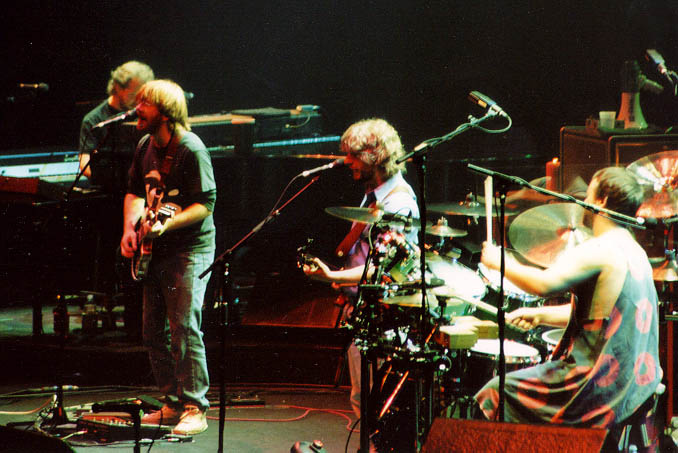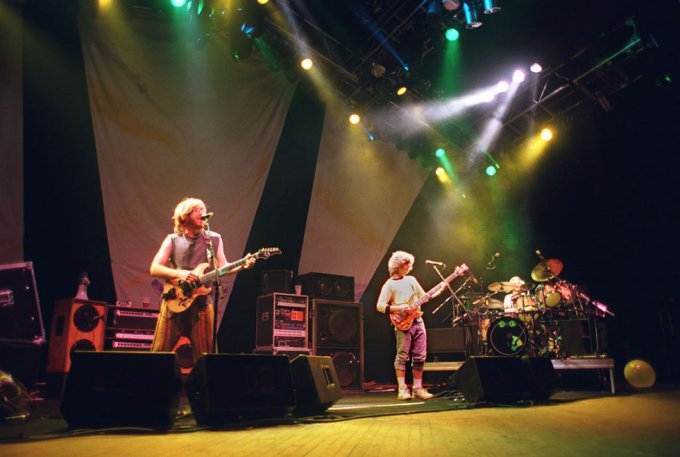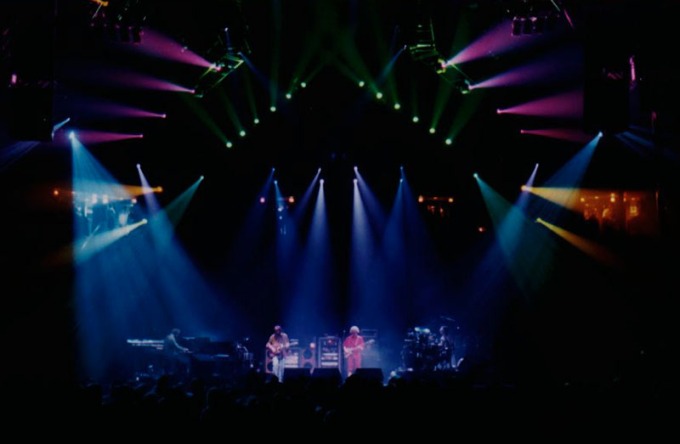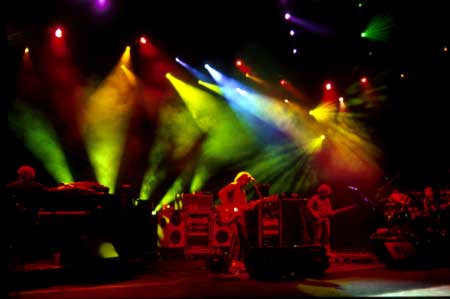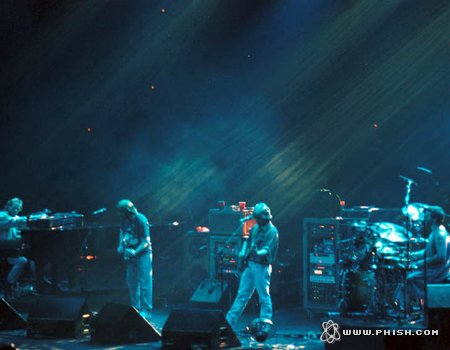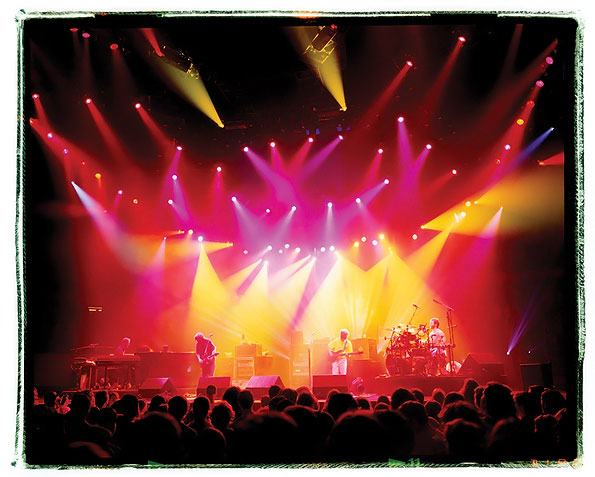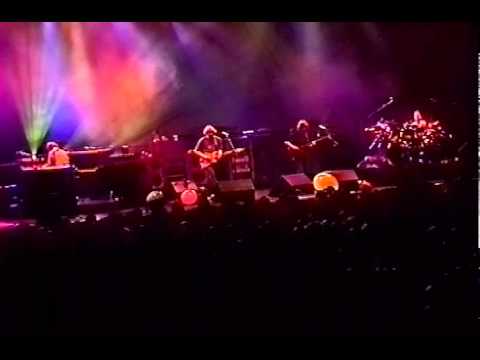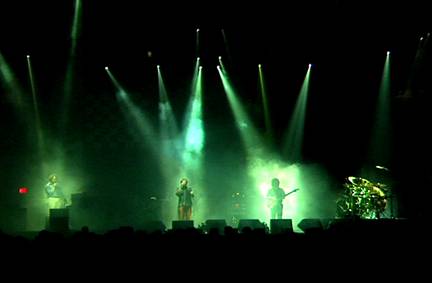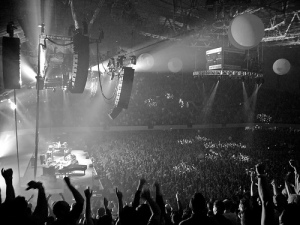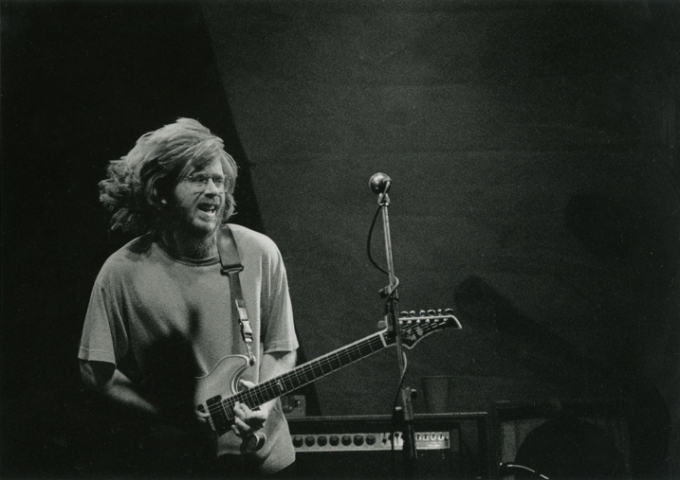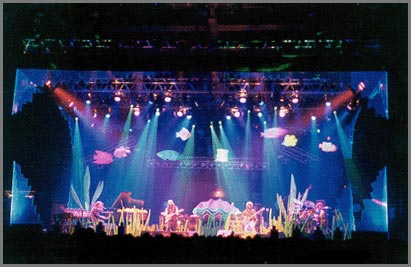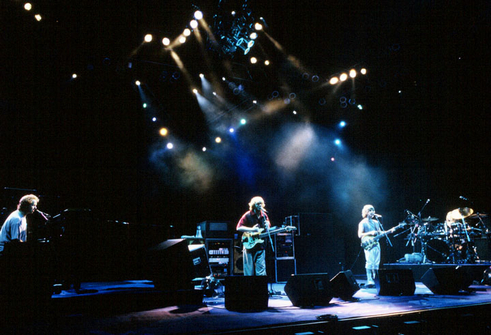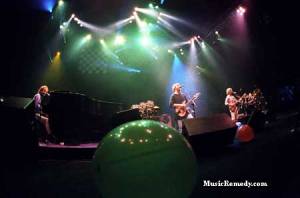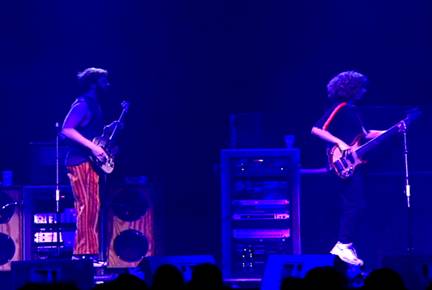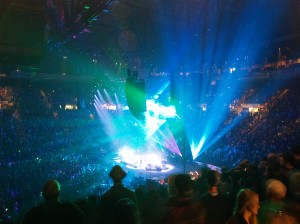By most accounts 12/30/1993 should never have happened.
With a torrential blizzard encompassing the Northeastern United States, most fans traveling from New Haven, CT to Portland, ME were either caught in virtual whiteouts or forced to wait until the very last minute to travel.
For those who were in Portland in the hours preceding the show most had to brave sub-zero temperatures outside while waiting for the venue to shuffle everyone in. As had become a staple of Phish fandom over the past 10 years however, Phish fans would prove more than willing, & more than capable of overcoming seemingly any/all odds, any distance & any weather in the unyielding hunt towards the next Phish show. Be it Dec 1995’s NE Run; Fall 1997’s Denver –> Central Illinois –> Hampton Quest; the long march across Alligator Alley to Big Cypress; the rain-soaked hell-slog to Coventry; or the overnight cross-country hauls throughout 3.0, Phish fans were always ready to hit the road – no matter the conditions – in search of the musical highs Phish provided.
More often than not, Phish would repay their efforts in full.
On such nights when it took an extra effort just to get to a show, there’d often be a palpable energy in the air – tension one could reach out and clutch onto – where band & audience engaged in a back & forth exchange of riotous celebration & shared camaraderie brought upon by years of shared musical unity. With each Phish show being a wholly new & unique experience, with each crowd being compiled of dedicated fans who’d seen the band countless times & discussed them as one would their favorite baseball team, with each venue & city providing its own historical backdrop to the band’s performance, & with the potential always there for a historical, boundary-pushing jam, &/or unexpected bustout, &/or tongue-in-cheek inside joke from their Burlington days, it’s no wonder nights like 30 December 1993 resulted in some of the most significant shows the band ever played.
And yet, for all of the immediate table-setting that logistics played in making 12/30/1993 one of the best shows of that crucial year – not to mention one of the most enduring performances of Phish’s overall career – perhaps what most sets it apart from other shows is its significance as one of the ever-special “Night-Before-The-Night” shows.
The concept of the Night-Before-The-Night is as uniquely Phish as any.
In the same vein as their ever-changing, unpredictable setlists, their surprise Halloween covers of Full Albums, their litany of bustous & special guests & gimmicks that dot their live catalogue, the Night-Before-The-Night is a singular way for the band to catch their crowd on their heels and deliver a memorable – if not wholly unexpected – concert experience. Like the sheer childish thrill of a surprise gift on Christmas Eve, or the rehearsal dinner for your best friend’s wedding that parties deep into the night, the Night-Before-The-Night is a celebratory result of pent-up energy, anticipation, & a shared history that bursts uncontrollably ahead of schedule.
It’s a sensuous feeling rooted deep in youthful excitement and unbridled anticipation.
It’s the party the night before finals. It’s the unrivaled sense of freedom that comes with clocking out the night before your flight to someplace warm & very far away. It’s walking into your apartment the night before your birthday to find 20 of your best friends cloaked in darkness, exalting their love and friendship for you.
It’s all of these moments of unexpected celebration and tensional release; only here it’s shared with 20,000 people, hosted by your favorite band, whose entire career has been built on capitalizing on these very moments.
If there’s any Phish show you ever need to be at, it’s The-Night-Before-The-Night.
————
For a show like The-Night-Before-The-Night to even occur there has to be “The Night” for there to properly be a “Night Before.”
This often comes in the form of holiday shows – 4th of July, Halloween, NYE – festivals, tour finales, & any otherwise overly-hyped show due to venue locale, date, et al. Such shows are often the ones wherein which the band feels such an overwhelming amount of pressure to deliver that often times their nerves are released one show prior as a means of lessening the expectations for the highly anticipated performance. In some cases this unexpected and unexplainable release tends to water down the originally hyped show as a result.
In the same vein as the Wild Card rounds of the MLB & NFL playoffs, and the first round of the NBA Playoffs tend to be more electric and bombastic than the more prodding later rounds, there’s something about the anticipation of a BIG night that lends itself to the shows preceding it.
Some of the most revered Phish shows in history are a direct result of this alchemic composition. Beyond 12/30/1993, many fans look to 10/29/1995, 08/14/1996, 12/30/1997, 08/12/1998, 07/25/1999, 02/28/2003, 07/29/2003, 12/01/2003, 12/30/2009, 10/30/2010, 08/28/2012 & 10/29/2013, among others, as further examples of legendary nbTn’s.
In person these are some of the most exciting and unforgettable shows one could catch. They cultivate the sense of Phish being your own personal secret while also making one feel as if they’re in on some spectacular joke few others will ever quite understand.
On tape these shows reverberate with electricity & a pop that separates them from all others. It’s not so much that they’re “better,” per se, than other shows, more so that they contain within them the same cognizance of dangerously tampering with larger forces that comes with sneaking out of your parents house at 3am, or skipping class to smoke pot with your best friends.
Senses elevated, each song tends to carry more weight, each jam more significance, each ovation more reverberation.
From the tension in Trey’s voice as he delivers the Forbin’s Narration on 12/30, or the maniacal outburst that results from the nearly-900 show bustout of Sneakin’ Sally four years later, to the unparalleled appearance of Jeff Holdsworth on 01 December 2003, to the Tweezeppelin madness that overtook the second set on 10/30/2010, there’s often no match for the energy output that comes from the pure shock value that occurs on the nbTn.
It’s unsurprising that on these nights the band tends to pull out all the stops. For a band that’s built its entire career on a devoted partnership with their crowd, the awareness of, and emotional reaction to such a show could never be lost on the performers.
These are the nights where storytelling is most likely to occur. Jams are typically extended to surreal & ethereal heights. And a selection of choice rarities & bustouts are dropped seemingly at will. These are the nights when you review a setlist in the hours following the show’s conclusion & find you have to pick your jaw up off the floor. These are the nights when it feels like Phish won the NCAA Title as an 8th Seed.
They are as shocking as they are monumental & as rewarding as they are unexpected.
With a New Year’s Eve show planned for the following night at the Worcester Centrum – a venue the band had been working towards playing at for five years – 12/30/1993 was in many ways the first every Night-Before-The-Night show in Phish’s history. And while the NYE show would more than satisfy diehard fans with its Greatest Hits-esque setlist, unified “we’re all in this together” vibe that permeated throughout, and the all-time version of Harry Hood that capped off the 3rd Set, many overlooked 12/30 as little more than an appetizer for 12/31 in the days and weeks leading up to it.
Just four years earlier Phish had packed The Paradise in Boston through word of mouth – and the help of Greyhound Buses – as their very first headlining gig in Beantown. A city that feels in many ways like the capitol of the Northeastern Kingdom, it’s always been like a second home for Phish. Its summer shed, Great Woods, hosted the final Gamehendge performance in 1994, the Fleet Center hosted their 20th Anniversary show in 2003, it was the site of two emotional sendoff shows in 2004, in 2009 the band chose Fenway Park to usher in their first proper tour in five years, and in 2013 the revamped Centrum (now the DCU Center) hosted two shows in October that felt as close to a 30th Anniversary Celebration as any.
To close out a year as monumental as 1993 in The Centrum would be yet another step forward for a band that had yet to relinquish their foot from the gas in nearly ten years of growth and development.
As Phish would show on 30 December 1993 however, there’s rarely a time when you can assume they’ll simply mail a performance in. Regardless how amped they & their fanbase was for the NYE show in Worcester, there was simply no way 1993 Phish was going to allow the gig in Portland to be forgotten.
As this show would prove for years to come, the shows where Phish is least expected to deliver are often times the most memorable ones of them all.
————
By the end of 1993 Phish was a serious musical and artistic force to be reckoned with. A national touring act that had continuously pushed themselves both creatively and artistically, they’d spent the past two years touring without restraint in effort to evolve beyond the tight-shipped machine they’d spent the better part of 1989 – 1991 becoming.
The Spring of 1992 had seen them expand their setlist and their improvisational abilities, while their time spent opening for Santana that summer had given them the chance to witness first hand the immense possibilities of band/audience connection through live improvisation. No longer the lackadaisical, wide-eyed college students jamming at house parties and in dorm cafeterias, they were ready to push their music deep into the unknown in a professional, and an artistic manner.
In early 1993 Phish spent five months on the road. In a tour that saw them cross the nation twice in just over 3 months, the band consistently tinkered and experimented towards further improvisational expansion. They carried themselves with a swagger that could only result from having played nearly 400 shows in the previous four years. Their sound fuller, their shows more fluid, their crew stable, they now began a process of outward expansion that would eventually lead them to the abstract explorations of November 1994 and June 1995.
David Bowie became a prominent opener, while Tweezer continued its evolutionary expansionism towards its eventual status as the ultimate Phish jam. The Big Ball Jam, one of a number of examples of band/audience interplay – introduced in late 1992 – was played nightly, allowing the band the opportunity to shed their artistic self-consciousness while the audience directed their music. For whatever shortcomings it had in terms of listenable music, it was yet another example in a line of band-initiated exercises that would help to bridge the gap between them and their audience, while also broadening their perspective on what was possible with live music.
Shows such as 02/23, 03/16, 03/30, 04/14, 04/18, 04/30, 05/03, & 05/08, among others, displayed a Phish far more relaxed in terms of setlist construction than they’d been in years past. During many of the aforementioned second sets, songs like Tweezer, Stash, David Bowie, Weekapaug Groove and Mike’s Song could expand far beyond the previously understood frames of musical construction. Direct, fully-flowing, organic segues became a far more typical aspect of second sets. And while their jamming was still rooted in a frenetic dissonance that bordered on shock value at times, it was clear by tour’s end – as heard in the 05/03 Tweezer -> Manteca -> Tweezer, and the 05/08 David Bowie -> Jessica -> David Bowie -> Have Mercy -> David Bowie – that the band’s expansionist efforts were beginning to blossom in melodic terrains of improvisational music.
Early on in the year they played a show in Atlanta, GA that would stand as one of the most important of their entire career. To this day 20 February 1993 is still revered as one of the critical moments in Phish history.
Taking a leap forward within the confines of a single show in a way they hadn’t since the mid-80’s, Phish fused the tight and explosive sound they’d crafted over the previous four years with the exploratory origins they’d been founded in. Wielding a set of segues, teases and jams in and out of Tweezer and Mike’s Groove, a porthole opened.
Phish would never be the same.
No longer would gimmicks & stories & Fishman joke-songs & secret languages & pure energy be enough to make a show. To move forward as artists in pursuit of their goal of producing linear, equal, & completely unified music through live, improvisational jamming, the band would begin a process of shedding their own egos and exploring the various musical avenues their songs could take them.
Later that year, during the fateful month of August 1993, the band continued to tinker with the formula they’d established throughout the previous four years, here using the “Hey Hole” jamming exercise to cultivate new lines of communication and new avenues for improvisation and linear musical communication. While the month of August is revered as one of the most impressive of their entire career – along with June/November 1994, December 1995 and November/December 1997 – the entire Summer Tour proved to be a massive breakthrough for the band. Shows like 07/16, 07/17, 07/24, 08/02, 08/07, 08/09, 08/11, 08/13, 08/14, 08/20, & 08/28 stretched the confines of what a concert could be in theory, and provided Phish with further proof that their energy & precision wasn’t at risk with a refined emphasis on experimentation. To the contrary, Phish discovered that by emphasizing improv, the energy of their concerts, and their trust within each other as artists, only solidified their original product. Oftentimes they’d find themselves writing new songs and themes within jams as can be heard in the 08/11 Mikes, 08/13 Gin, & 08/14 Antelope, among others.
The sets and shows that produced these groundbreaking musical experiments were thusly enhanced by their existence.
That Fall Phish would take a break from touring to record their most accessible and taught record to date: Hoist. An album recorded with a keen eye on an altogether different type of musical expansion – here popular exposure – was a reflection of the halcyon year 1993 was for Phish. Still young enough to devote all their waking hours to their craft, devoid of the responsibilities to family, crew and a burgeoning fanbase, fixated on an abstract goal to produce completely egoless music in a live setting, they had seemingly all the time in the world to push their own artistic goals forward while still spreading their name.
It was the kind of period of artistic fruition and popular expansion that any musician would kill for some ten years into their career. It’d been a long road to this point, but now here, Phish intended to make the most of the opportunities before them.
————
The Cumberland County Civic Center is a 9500 multi-purpose arena in downtown Portland, ME. Home to the AHL Portland Pirates it’s like many of the 60’s & 70’s era concrete sheds that have witnessed some of the best shows throughout Phish’s career. Encased in cement, graced by neon-lit corporate sponsorship, ripe with stale beer and the lingering scent of processed foods, acoustically unreliable, employed by the least abled-bodied workers in the American workforce; these are the venues that marked the arrival of Phish as a national touring act, and that they have called home on Fall Tours, Winter Tours & New Years Eve Runs ever since.
A venue that was ushered into live-music-existence with a ZZ Top performance in 1977 – and is ultimately famous for the fact that it was to have been the site of an Elvis concert were he to not have died the morning of 16 August 1977 at his home in Memphis – it’s one of the industrial and pop-cultural pinpoints that’s put Portland on the map. Located in the heart of downtown Portland, a town known for outdoor enthusiasts, green energy, and the fact that it’s home to the most restaurants per capita in America, the venue and the city are the kind of Northeastern haunts that have always felt like home for Phish.
The original capitol of Maine, the Portland of the East, is the state’s most populous city; it’s a city that’s known its own fair share of hardship, resiliency, & ultimately, recovery.
Hit hard by the British trade embargo of 1807, the city grew in both size and stature following the War of 1812. It was the site of the Portland Rum Riots in response to Maine being the first state prohibiting the sale of Alcohol, and in 1863 its harbor was the site of one of the northernmost battles of the Civil War. Nearly destroyed in 1866 due to a fire that resulted from Fourth of July celebrations gone awry. It’s a town that’s played as distinctive a part in its region’s history as it has in reveling in the fruits of Americanization.
An early 20th-Century rail hub, it faced marked economic decline during the mid-century due to the invention of icebreaker ships which allowed freight ships to reach Montreal without having to transport goods through Portland. In the mid-70’s the construction of the Maine Mall severely impacted downtown Portland’s economy, a trend that would only finally be reversed in the 1990’s as businesses began opening and revitalizing the Old Port.
Like many midsized American cities it’s experienced a cultural and economic revitalization over the past two decades as more and more Americans have realized the aesthetic importance of local production & authentic business centers.
Home now to a bustling service industry, the main financial services of Maine, and some of the most dedicated urban farmers in the US, it’s a city that resembles in many ways the remarkable career Phish has cultivated these last 30 years. Resilient in the face of seemingly insurmountable odds, adaptable to changing tides and bursts of inspiration, amicable to keep people coming back for more, Portland was the fitting town to play host to one of the most memorable shows in Phish history.
————
 Stepping to the stage in front of an eager and packed house, Phish opened with one of their storied, compositional masterpieces: David Bowie. A song known for its eerie kinetic energy as much as it is its open-ended spaciousness, it’s the kind of song that announces a BIG show simply in its presence alone. Containing only two lyrics: “David Bowie” & “UB40” – both shouted with youthful irreverence and a satirical nod towards their arena rock forbearers – the song is built upon the duality of its maddeningly spinning harmonic interplay, and ultimate release into the musical unknown.
Stepping to the stage in front of an eager and packed house, Phish opened with one of their storied, compositional masterpieces: David Bowie. A song known for its eerie kinetic energy as much as it is its open-ended spaciousness, it’s the kind of song that announces a BIG show simply in its presence alone. Containing only two lyrics: “David Bowie” & “UB40” – both shouted with youthful irreverence and a satirical nod towards their arena rock forbearers – the song is built upon the duality of its maddeningly spinning harmonic interplay, and ultimate release into the musical unknown.
Complete with repeated references to Aerosmith’s “Dream On,” this performance struck the crowd at once. As Trey directed the song back to its musical home through a torrential cacophony of blistering leads, the crowd responded with the kind of electricity that can only be a result of abject surprise and bewilderment over the course the show had taken right out the gates.
A night when many would expect the band to proceed with measured caution and ease – essentially reserving the best for NYE – here they were, immediately in full attack mode, assaulting the crowd right out the gates.
The entire first set is a clinic in structural flow and energy.
From Bowie we’re brought to Weigh’s comedic shrill and musical balefulness. The Curtain retains Bowies composed complexity, reminding those in attendance – and listening years later – that, ultimately, Phish is an artistic project to “please me,” sans all regrets.
Sample In A Jar, Paul & Silas, & Rift are the kind of playful, energized, reductive songs that mark time and flow within a first set. Presented here with an added dose of electricity, the solo from Sample engulfs the arena in the way fans would come to expect from it for years to come.
In Col Forbin’s Trey launches into a sprawling tale that originates within the CCCC wherein which the Pirates ice rink – upon which the crowd is watching the show from – melts away, setting the entire crowd at sea until they drift away into the mythical land of Gamehendge. A song that had become something of a rarity even at that point in their career (It’s only been played 25 times in the 21 years since) it’s – along with its musical partner, The Famous Mockingbird – the kind of song that immediately marks whatever show it appears at as singular and special. One needs only to think of 11/17/1994, 12/01/1995, 08/14/2009, and 07/03/2011 to realize its significance within a setlist. In the same sense as Harpua did on 12/30/1997, Destiny Unbound on 02/28/2003, and Crosseyed on 07/29/2003, the Forbin’s -> Mockingbird on 30 December 1993 immediately gave the show an added dose of mythical lore and historical relevance.
Played only seven times throughout 1993, Bathtub Gin had yet to fully assume the role of a complete rotational song. However, its performance just four-and-a-half months earlier in Indianapolis had been crucial in bursting open the musical confines that Phish was increasingly desperate to move beyond. A jam that moved from vocal-jam-gimmickry to dissonant guitar swells to arena rock grooves to a frenetic peak to a joyous, funky breakdown in the matter of 15 minutes, it was one of many improvisation journeys throughout August 1993 that worked to release Phish from their own self-consciousness and equip them with the confidence needed to run assuredly off the veritable musical cliff. While the version on 12/30 didn’t traverse quite as far from home as the 08/13 Murat Gin did, it still relied on the bottled-up energy and experimental fervency that defined so much of their improvisation throughout 1993.
Closing with an absolutely revolting acapella cover of Skynnard’s Freebrid was the kind of tongue-in-cheek Phish-nonsense needed to close out a set such as this. Energy sustained, they exited for their “15 minute break” having equally stunned and warmed the packed house.
Perhaps one of the telltale signs of a nbTn show is the explosiveness that often overtakes a crowd during setbreak. A setbreak like this was filled with exclamations in the beer lines, high fives amongst complete strangers, and the unified sense that this was the only place on Earth one would want to be.
In Set II Phish compiled nothing short of a masterpiece in terms of set construction, improvisational experimentation, and overall energy released. Fluid from one song to the next, containing within it one of the critical jams of the era, not to mention an all-too-rare oldie full of Phish lore, and a massive bustout for their East Coast faithful. In short it’s one of those sets any respectable Phish fan has heard at least once, and any diehard knows by heart.
A precursor to the jam-heavy, seguefests that would mark their peak-periods in 1995 and 1997, 12/30/1993 II is the kind of set one presses play on, and never skips a track, nor stops listening until its conclusion.
Opening with their cover of Deodato’s Also Sprach Zarathrustra, otherwise known as 2001 – a song which opened no less than 19 second sets in 1993 – was equal parts anticipated punch and a missionary pronouncement of the set to come. In the same way that its anthemic jam ushered in memorable sets on 08/07, 08/14 and 08/20, here it worked as a precursor to a set that would be as transformational as it would be celebratory.
It was, however, when they dropped into Mike’s Song that everything changed.
One of the most revered and oldest songs in Phish’s catalogue, Mike’s Song moves from the poppy nonsensical lyrics written by an 18-yr-old Mike Gordon into a dark and prodding jam that, at its best, opens to unending musical possibilities. Just that year, during its performances at The Roxy, and in August on 08/11 and 08/13, the song had expanded considerably as the band sought to carve out the underbelly of the F#/B jam. Yet, where those three versions focused firstly on the varied segues that could emerge from the jam, and later on the wacky staccato dissonance the jam catered to, the version on 12/30 was far more melodious than any Mike’s had been before. Swimming through the minor-keyed jam the song produced, Trey built the band towards an anthemic peak that fit both the show’s setting, and the place they found themselves in at this point in their career.
Perhaps though, the most remarkable thing about this jam is its dexterity. As the band quieted down, they brought in a sense of darkness ultimately directing the jam into The Horse by way of a deft segueway.
The jam, rooted in harmonic bliss, capable of evolving with an effortlessness that would define their best jams in the years to come, was a critical turning point for the band in their evolution from prankster aficionados to true artists.
Compiling the middle part of Mike’s Groove with such rarities (for its time) as Punch You In The Eye and McGrupp was the kind of understood nod from the band that colors all great nbTn setlists. From 10/29/1995’s It’s Ice -> Kung -> It’s Ice -> Shaggy Dog and 12/30/1997’s Carini -> Black-Eyed Katy -> Sneakin’ Sally (Reprise)> Frankenstein encore, to 02/28/03’s Soul Shakedown Party and 12/30/2009’s Tela, one of the sure signs that you’re at a nbTn show is the appearance of the rare songs most fans spend years chasing down.
After a spirited jaunt through Weekapaug Groove – a jam that mirrored the Mike’s in both its melodic burst and its foreshadowing of Phish maximalist playing of 1995 – closed out the near 45-minute Mike’s Groove, Fishman’s take on Purple Rain brought the laughs before the last surprise of the night was delivered.
Only seen twice since 1991 – and unseen on the East Coast since 11/15/1990 – Phish closed out the second set with a triumphant version of one of their most beloved songs: Slave To The Traffic Light. Responding to the show-long pleads from their audience; it was one final gift from the band in an evening full of them.
Cementing the show as an all-timer, and a must-hear tape, the appearance of Slave made it essential that nearly every Night-Before-The-Night show include a similarly big bustout. As 10/29/1995’s Shaggy Dog, 12/30/1997’s Sneakin’ Sally, 02/28/2003’s Destiny, 07/29/2003’s entire first set, 12/01/2003’s Long Cool Women In A Black Dress, and 12/30/2009’s first set, would later display, the bustout would play a vital role in raising the bar of a show, especially one as rare as a nbTn.
Closing things out with a frenzied Rocky Top & Good Times Bad Times encore, the band left their giant Aquarium stage and headed south towards Worcester, MA. The New Year’s Eve show would deliver on a level only seen twice more – 1995’s three-set masterpiece & 1999’s millennial all-nighter – and would rightly be regarded as one of the best shows the band’s ever played.
Yet it was 12/30 that created an endless debate amongst Phish fans about which show was supreme – the answer which, spoke volumes towards what kind of music you preferred from Phish – and opened the door into yet another possibility for the band in terms of the live concert experience.
For as the concept of The-Night-Before-The-Night proves, Phish is far more than simply a Rock & Roll Band in the traditional sense.
For them, the live concert is a living-breathing organism, in many ways like a Broadway Play. The idea that there shouldn’t be an element of surprise, nor a reward for those fans who make the extra effort to see even their lesser-hyped shows is something that Phish has always worked to transcend.
As the band would continue to grow in both stature and artistic accomplishment – as more and more shows became hyped in terms of promotion and fanfare – the concept & possibilities & opportunity to unleash unexpected doses of energy always lingered and was always available for the band through the shows that had remained off the radar of many of their fans. Yet another reminder as to why to never miss an upcoming Phish show. More often than not, if the band has a heavily hyped gig on the horizon, the best show to catch is the one most are overlooking.







